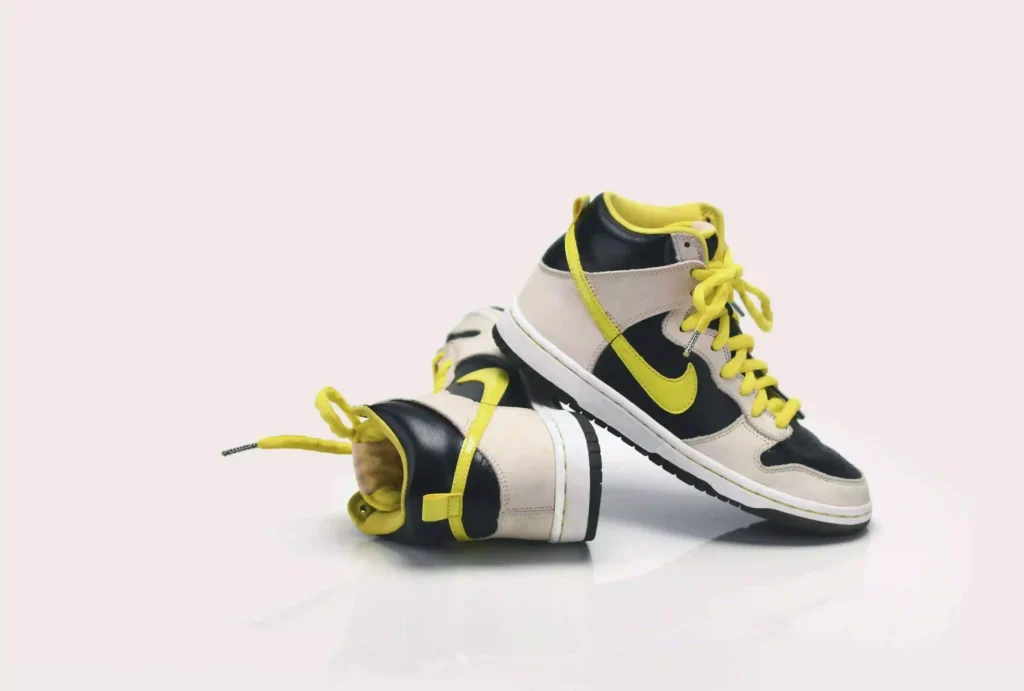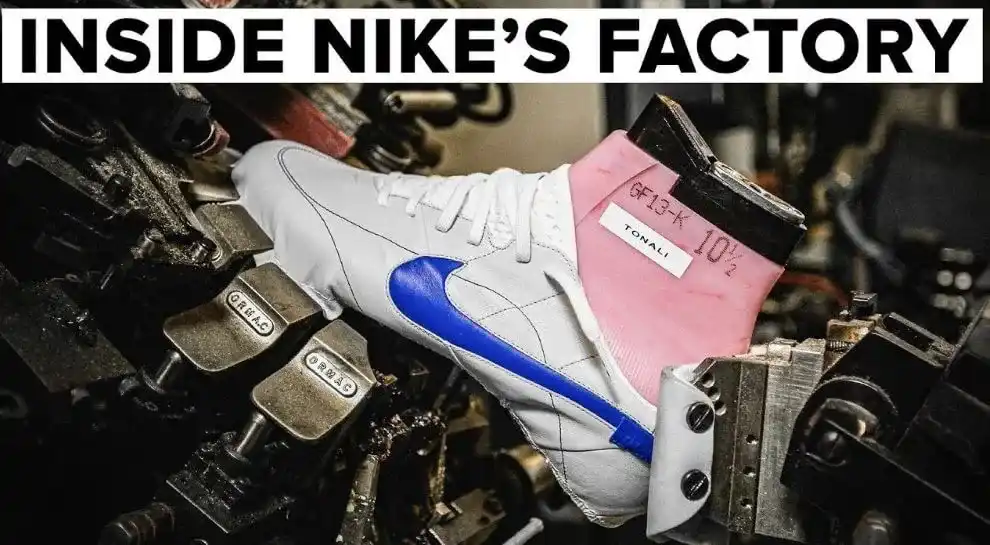Introduction
If you’re a sneakers fan, you’ve undoubtedly heard of Nike, a titan in the sneaker industry.
A global brand, Nike is a leading manufacturer of athletic shoes, apparel, and accessories.
The company, founded in Oregon in 1964, still maintains its base there. However, it’s widely known that Nike outsources a significant portion of its production to regions such as Central America and Southeast Asia, capitalizing on lower material and labor costs.

So, where are Nike shoes made? You’ve likely thought about this question several times. The answer could be more straightforward since Nike shoes aren’t manufactured in just one place. A Nike online map explains where shoes are made.
Today, I will unravel this mystery before you hit the ‘Add to Cart’ button. So, let’s dive in.
Table of Contents
- Introduction
- What is Nike?
- Nike’s Global Manufacturing Strategy
- Where Are Nike Shoes Made?
- Major Manufacturing Countries
- The manufacturing process of Nike sports shoes
- Some Of The Most Nike Shoes Ever
- Conclusion
- FAQ
What is Nike?
Nike is a multinational brand based in Beaverton, Oregon. The company designs and sells sports equipment, apparel, and accessories. Sports shoes are its biggest business.
Phil Knight, an athlete, and his coach, Bill Bowerman, founded the company on January 25th, 1964. Initially, Nike focused on producing premium sports shoes specifically for athletes.
Gradually, these shoes also gained popularity among the general public, who began viewing them as a status symbol.
Over time, Nike shoes have evolved into the ultimate must-have for sports enthusiasts and those with a passion for athletics.
Nike’s Global Manufacturing Strategy
Nike, originally a local manufacturer in the U.S., expanded its production globally due to increasing demand and cost-effectiveness. The company strategically set up manufacturing facilities in China, Vietnam, and Indonesia, considering labor availability, cost, proximity to raw materials, and logistics.
This diversified approach allows Nike to keep up with fashion trends and shorten product life cycles. It mitigates socioeconomic or political instability risks in a single region, ensuring a steady global supply of their products.
Where Are Nike Shoes Made?
Approximately 600 factories across 46 countries are dedicated solely to producing Nike shoes. Among these Nike suppliers, roughly 36% each are based in China and Vietnam, while another 22% are in Indonesia.
Here’s a list of the top 10 wholesale vendors where are nike shoes made now:
- Eagle Nice International Holdings
- Location: China
- Specialization: Footwear, jackets, sports pants, sweaters
- Fulgent Sun Corps
- Location: China
- Specialization: Sports and outdoor footwear
- Delta Galil Industries
- Locations: Various facilities throughout Southeast Asia
- Specialization: Socks and activewear
- Shenzhen Sanzhiant Industrial Co Ltd
- Location: China
- Specialization: Basketball shoes and accessories
- Teddy Trading Co Ltd
- Location: China
- Specialization: Sports shoes and sneakers
- Pou Chen Corporation
- Location: China
- Specialization: Athletic and casual footwear
- PT Pan Brothers
- Location: Indonesia
- Specialization: Winter jackets, shorts, golf shirts, etc.
- Quanzhou Maike Trade Co Ltd
- Location: China
- Specialization: Sports shoes and apparel
- Guangzhou Beiweiyuan Trading Co Ltd
- Location: China
- Specialization: Sports shoes and sneakers
- Anji Tianhuangping Landa – Nike wholesale vendor division
- Location: China
These vendors are crucial in bringing Nike’s innovative designs to life.
Major Manufacturing Countries
China is the largest manufacturing country for Nike. So, do you know where are Nike shoes made in China? You will be surprised to know that Nike has some major manufacturing companies like China, Japan, Korea, etc. Let’s take a closer look at their manufacturing facilities.
China

China is critical to Nike’s manufacturing strategy, hosting over 160 factories, with 46 dedicated to footwear production. This presence, resulting from Nike’s 1990s Swoosh Index strategy to reduce costs, contributes significantly to the company’s global output.
Despite controversies over alleged forced labor involving Uyghurs, which Nike has consistently denied, China remains a major hub for Nike’s production and distribution domestically and across Asia.
Japan
Japan was one of the first countries where Nike established factories, with the first opening in 1964. Although it currently houses 12 facilities, including three footwear-specific ones, production has decreased due to rising labor costs. Yet, Japan remains an important part of Nike’s manufacturing network.
Some of Nike’s most iconic shoes, like the 1974 Wimbledon Tennis shoes, were produced here. However, in recent years, Nike has shifted its focus toward countries with cheaper labor, such as Vietnam and China.
Vietnam
Vietnam is a significant manufacturing hub for Nike due to its affordable labor. With approximately 200 contracted factories, Vietnam has become one of Nike’s largest manufacturing markets globally. As of 2023, Vietnam is the top producer of Nike shoes, highlighting the country’s importance to Nike’s footwear operations.
Indonesia
Indonesia ranks third in Nike’s footwear production, following China and Vietnam. Approximately 28 Nike factories in Indonesia are dedicated solely to footwear production. A recent addition includes a factory in Majalengka, West Java, capable of producing over 15 million pairs annually.
Factors such as inexpensive labor and efficient operations have substantially increased Nike’s production in Indonesia over recent years. Besides footwear, Indonesia also hosts apparel, equipment, and raw material production factories.
South Korea

South Korea, while not housing as many factories as other countries, still plays a significant role in Nike’s global footwear production. Around 17 factories in South Korea are dedicated to producing Nike shoes, making it a noteworthy player in Nike’s manufacturing network.
The manufacturing process of Nike sports shoes
Nike’s manufacturing process is outsourced to wholesale vendors globally, necessitating a centralized production approach to ensure consistent shoe quality.

Nike employs a two-step integrated process in its shoe manufacturing. All vendors receive specific inputs throughout the production process, ensuring uniformity in the final product irrespective of location.
The initial step involves procuring the necessary raw materials for shoe production. These materials, sourced globally, are then distributed to factories worldwide. Nike ensures standard quality across all its products by stipulating that vendors use only these supplied materials.
Key raw materials for Nike shoes include organic cotton, leather, rubber, recycled polyester, PVC, PVA foam, mesh fabric, and lightweight plastic. These materials are sourced locally or internationally and sent to Nike’s vendors for production.
Step-By-Step Manufacturing Process Of Nike Shoes
- Step 1: Utilize machines to slice foam sheets into the desired shoe sole shapes, a process similar to cookie cutting. The soles are then sorted according to size.
- Step 2: Cut additional fabric pieces into various shapes to constitute the shoe’s main body. Materials like mesh fabrics, leather, and PVC are employed in this phase. The ultimate appearance of the shoe is heavily reliant on the work carried out in this step.
- Step 3: Combine the shoe body created in Step 2 with the sole from Step 1. The two parts are bonded using water-based glue, and machines exert mechanical pressure to ensure a robust connection, thereby providing structural integrity and durability to the product
- Step 4: Attach the shoe’s upper sole to the body assembled in Step 3. This segment is shaped by heating it in a plastic mold before it’s incorporated with the rest of the shoe. After this stage, the product closely resembles a shoe but isn’t fully complete.
- Step 5: Apply final stitching all around the product to reinforce it and hold all the pieces together. At this point, the shoe undergoes testing for potential wear and tear.
- Step 6: Following the initial quality check, final embellishments such as the logo, shoelace holes, and other decorative elements are added to the shoe.
- Step 7: The shoes are packaged and prepared for shipment after a thorough final quality check.
Some Of The Most Nike Shoes Ever

Now you know where are Nike shoes made, you should check out some of the most notable shoes Nike has ever made.
- Nike Air Force 1: Classic basketball silhouette, iconic design with a clean, versatile look. Price: $90 – $100
- Nike Air Max 1: Revolutionary visible Air cushioning introduced the Air Max series. Price: $110 – $130
- Nike Air Jordan 1: Michael Jordan’s first signature shoe, a basketball classic with timeless appeal. Price: $150 – $200 (standard editions, exclusive collaborations can be higher)
- Nike Air Max 90: Iconic running shoe is known for its bold color combinations and comfort. Price: $120 – $140
- Nike Air Max 97: Futuristic design with full-length Air cushioning inspired by high-speed trains. Price: $160 – $180
- Nike Air Max 270: Lifestyle sneaker with the tallest Air unit for exceptional cushioning. Price: $150 – $170
- Nike Air Presto: Lightweight, sock-like fit, known for its “T-shirt for your feet” comfort. Price: $120 – $130
- Nike React Element 55: Modern lifestyle sneaker with React foam cushioning for a responsive feel. Price: $130 – $150
- Nike SB Dunk: Skateboarding shoe popularized by collaborations and limited editions. Price: $100 – $120 (standard editions, exclusive collaborations can be higher)
- Nike Roshe Run (now known as Roshe One): Simple, lightweight design known for its casual and comfortable style. Price: $75 – $85
- Nike Blazer: Vintage basketball shoe with a retro look with modern materials and colors. Price: $85 – $100
Conclusion
Most Nike shoes are made in China and Vietnam. These countries make most of all Nike shoes. Other countries like Indonesia, Japan, Brazil, Taiwan, and South Korea also make Nike shoes. This means Nike makes its shoes in many different places around the world. Even though China and Vietnam make the most, Nike shoes are truly made globally.
However, you can be confident that no matter the style, Nike shoes are crafted with superior materials to meet your highest expectations.
FAQ
Where Are Nike Shoes Made From?
Nike shoes are produced globally in several countries, including China, Vietnam, Indonesia, Thailand, and more.
Are Nike shoes still made in China?
Indeed, China continues to be a significant manufacturing hub for Nike products.
Which country made Nike original?
Nike was originally founded in the United States (in Beaverton, Oregon) and started manufacturing there. However, production expanded to other countries over time to meet global demand.
Where in China are Nikes made?
Various regions across China, such as Guangdong, Fujian, and Jiangsu, host Nike’s shoe manufacturing facilities.
Why did Nike leave China?
There is no evidence to suggest that Nike has completely withdrawn from China. Like many global companies, Nike may shift its production sites based on factors like labor costs, logistics, and market strategies.
Are Nike shoes made in Korea?
While Nike operates manufacturing facilities in several countries, it is not typically associated with shoe production in Korea. The main production sites for Nike shoes are in Southeast Asian countries, notably China, Vietnam, and Indonesia.
